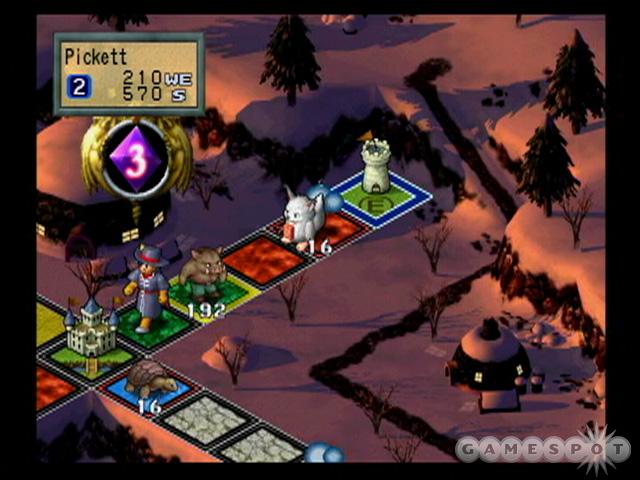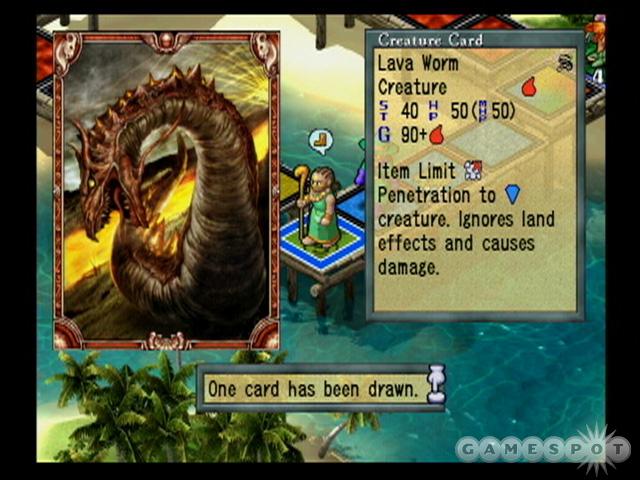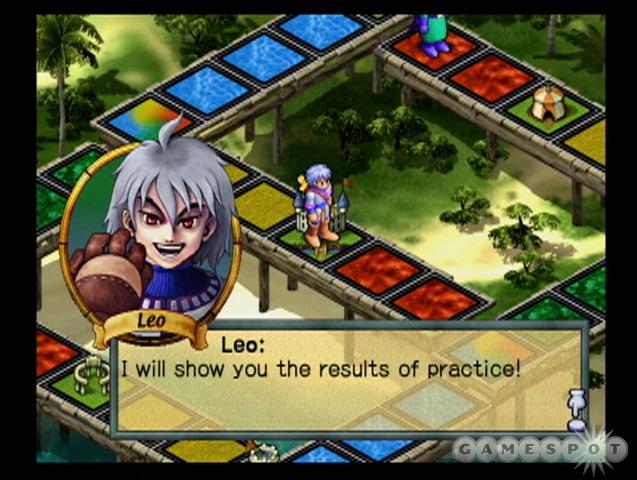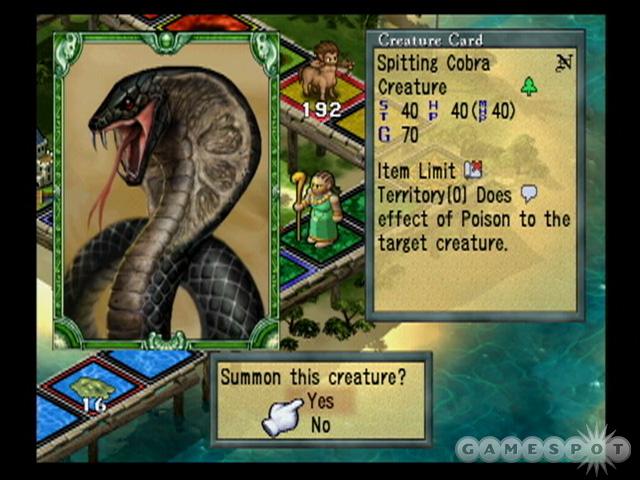You might expect that Magic: The Gathering and Monopoly would blend together about as well as oil and water, but these two influences combine for surprisingly fun and addictive results in Culdcept, the second North American release this year from long-dormant game publisher NEC. Culdcept actually isn't the first game in the series, which started out in Japan years ago, but it's the first that's been translated into English. The game's clean and attractive presentation certainly isn't flashy, and the hybrid card battle/board game matches that make up the gameplay can be both a bit complicated to learn and extremely time-consuming. However, the well-designed mechanics, combined with its sheer amount of content, make Culdcept easily recommendable to fans of strategy games and even to fans of role-playing games.

Culdcept is essentially a board game in which you use custom decks of 50 cards, which contain fantastical creatures and powerful items and spells, to compete against up to three other opponents. You move across each map by taking a random number of steps at a time--much like you would while playing Monopoly or any other board game--and you lay claim to the points on each map by summoning your creatures in them. As more of your creatures cover the land, you gain more magic power. The winner of a match is declared when a player reaches a certain overall magic power point total and makes it back to the starting point of the map. Placing creatures on the map is equivalent to placing hotels on real estate in Monopoly. So, if an opposing player lands on one of your spaces, he or she will pay a fine in magic points. However, he or she may try to defeat the creature that's guarding the space to avoid the fine and to try and claim the territory. This is a relatively simple explanation for a game that has plenty of strategic appeal, though there's a very real element of luck that keeps Culdcept from being a pure strategy game and keeps even the most experienced players on their toes and thus prepared for things to not go according to plan. An informative manual and plenty of in-game documentation, as well as some reasonably helpful lessons at the beginning of the story mode, will help get you up to speed pretty quickly.
There are nearly 500 different cards in Culdcept, which, in practice, feels like a whole lot. Most of these are beautifully illustrated and quite imaginative. They include just about every fantastical and mythological creature you can think of--and a bunch you can't. Undoubtedly, the luck-based matches will cause you some frustration from time to time. However, just because you land squarely on your opponent's strongest creatures several turns in a row or you keep drawing item and spell cards from your deck when you desperately need a creature, doesn't mean you're a lousy Culdcept player. You're just having bad luck. Since matches in Culdcept can easily wear on for more than an hour, though, bad luck can lead to disappointment. Fortunately, you earn new cards at the end of each match whether you win or lose. You do get more cards for winning, but there's still a reward for losing, which is nice. By giving you more cards at the end of each match, the game encourages you to stick through to the bitter end rather than give up if things aren't going your way. Besides, the balance of power tends to shift over the course of a Culdcept match, so, with luck and planning, you can overcome a significant deficit in magic power and still come out on top.

If you've played or heard of collectible card games before, then you can imagine that much of the inherent strategy in Culdcept comes from building a good deck. You can have multiple decks on file, which can be customized to be best-suited to particular maps or against particular opponents. Basically, a well-balanced Culdcept deck is one that includes creature cards from all five elemental affinities (neutral, fire, water, wind, and earth), as well as some good supporting item cards and spell cards. Creature cards should comprise the majority of your deck. Battles between creature cards literally consist of the respective cards smacking each other, and victory is simply calculated based on the creatures' striking powers and health powers, though most creatures have a few unique properties that are described on the cards. Even the weakest creature in the game can be useful in the right circumstances, whereas stronger creatures are relatively costlier to summon, so a balanced assortment of creature cards is key. Item cards are used to bolster your creatures when they're attacking or defending against other creatures, and they can easily offset any inherent weaknesses in those creatures. Spell cards can be used as you move about the map and can do such things as increase the number of steps you can move in a turn, decrease the enemy's movement, damage opposing creatures, and so on.
While there's no way to instantly put together a "best" deck from the cards you have available, editing your deck is a fairly intuitive process, and filters are available so that you can see, at a glance, how many cards of each type you have in that deck. You begin each match with six random cards from your deck, and you draw one more at the beginning of every turn, though you must discard one if you rack up more than six. If you exhaust your supply of cards, your deck is simply reshuffled. Therefore you needn't worry too much about discarding cards you need, nor do you need worry about running out of cards. Card sharks may find a lot of strategic appeal in Culdcept in trying to count the cards. If one of your high-powered creatures hasn't come up yet, and you know you're nearing the bottom of your deck, then you know that your heavy hitter is on its way.

Culdcept has a lengthy single-player story mode, in which you're guided around by a weird magical staff that needs your powers as a Cepter--a card battler--to save the universe. The story mode consists of a linked series of scenarios, though sometimes you'll unlock more than one scenario that you can attempt next. Certain scenarios will initially seem too difficult, but you can replay previous ones to earn new cards to better prepare yourself for the challenges ahead. The story mode's quirky tale and odd cast of characters provide enough cohesion to make this mode worthwhile; it adds just the right bit of context to all the battles. Also, single-player scenarios that you've completed become available in the game's versus mode, which is playable by up to four people.
Culdcept's versus mode is structurally identical to the story-based single-player battles against the challenging AI, but it can be a tremendous amount of fun in the way any good board game or collectible card game can. Players can use their respective custom decks in the multiplayer mode, which ideally means that each of you will need to have played your share of single-player battles, though this isn't a requirement. Optionally, you can even create custom game rules and computer opponents for use in the versus mode. A game like Culdcept could have greatly benefited from online multiplayer options, but it's actually very well suited to conventional single-system multiplayer competition.
Because of the huge variety of cards, and because of the inherently chaotic battles, Culdcept can be very addictive. You'll often want to play just one more match to see what new cards you get. And then you'll want to play just one more match so that you can try out your newly arranged deck. On top of that, the variety of different maps gives a noticeably different feel to each battle. It's not like Monopoly, where you're playing on exactly the same layout each time.
However, certain aspects of Culdcept can start to wear thin after a while. The game initially seems briskly paced, but eventually, you'll wish it played out much faster. The creature battles, in particular, seem to waste precious moments here and there, as each card's name is announced prior to the battle. These are nice touches that help make the presentation more attractive, but after hours of play, you'll wish they were optional. In larger matches against multiple opponents, you'll probably find yourself getting impatient while waiting for your next turn, especially in the crucial later stages of the match when everyone is pitting their creatures against one another. Also, the fact that the computer opponents emulate human players--they use the interface the same way you do--seems inefficient, though it does help convince you that you're playing against a worthwhile opponent rather than a cheating AI.

Culdcept looks and sounds quite good, though it's got a no-frills presentation. As mentioned, the cards themselves look quite impressive, featuring hand-painted illustrations from a number of different Japanese artists. The cards appear quite large, so you can clearly see what's depicted on each one. In stark contrast to the traditional fantasy art style used for the cards, the map graphics in Culdcept are filled with cutesy, isometric 2D characters, much like those found in strategy RPGs such as Final Fantasy Tactics. Each of the game's hundreds of creatures is depicted on the map by using its own little animated character, which is great, and the maps themselves are colorful and easy to read. Also, the battle effects between cards are surprisingly good. When one card damages but does not defeat an opposing card, you'll see visible tatters and holes appear on the opposing card. A male announcer declares each creature card and spell card that's played during a match, and he does an excellent job. A female announcer declares some other special events during battle, such as when you've crossed particular points on a map, but she'll inherently repeat herself often. Of further note, Culdcept's soundtrack is quite good, though it transitions somewhat jarringly between map music and card-battle music. It's still a good fit for the fantasy theme of the game.
Of course, it's not so much the presentation that makes Culdcept such an interesting game. Truthfully, though, the presentation does help quite a bit. Just as part of the appeal of Magic: The Gathering and other collectible card games is in seeing what imaginative illustrations can be found in each new pack of cards, it's easy to get hooked on Culdcept not just by virtue of trying to build a better and better deck with which to engage in the game's challenging and entertaining battles but just because the cards themselves are great and are truly are fun to collect.